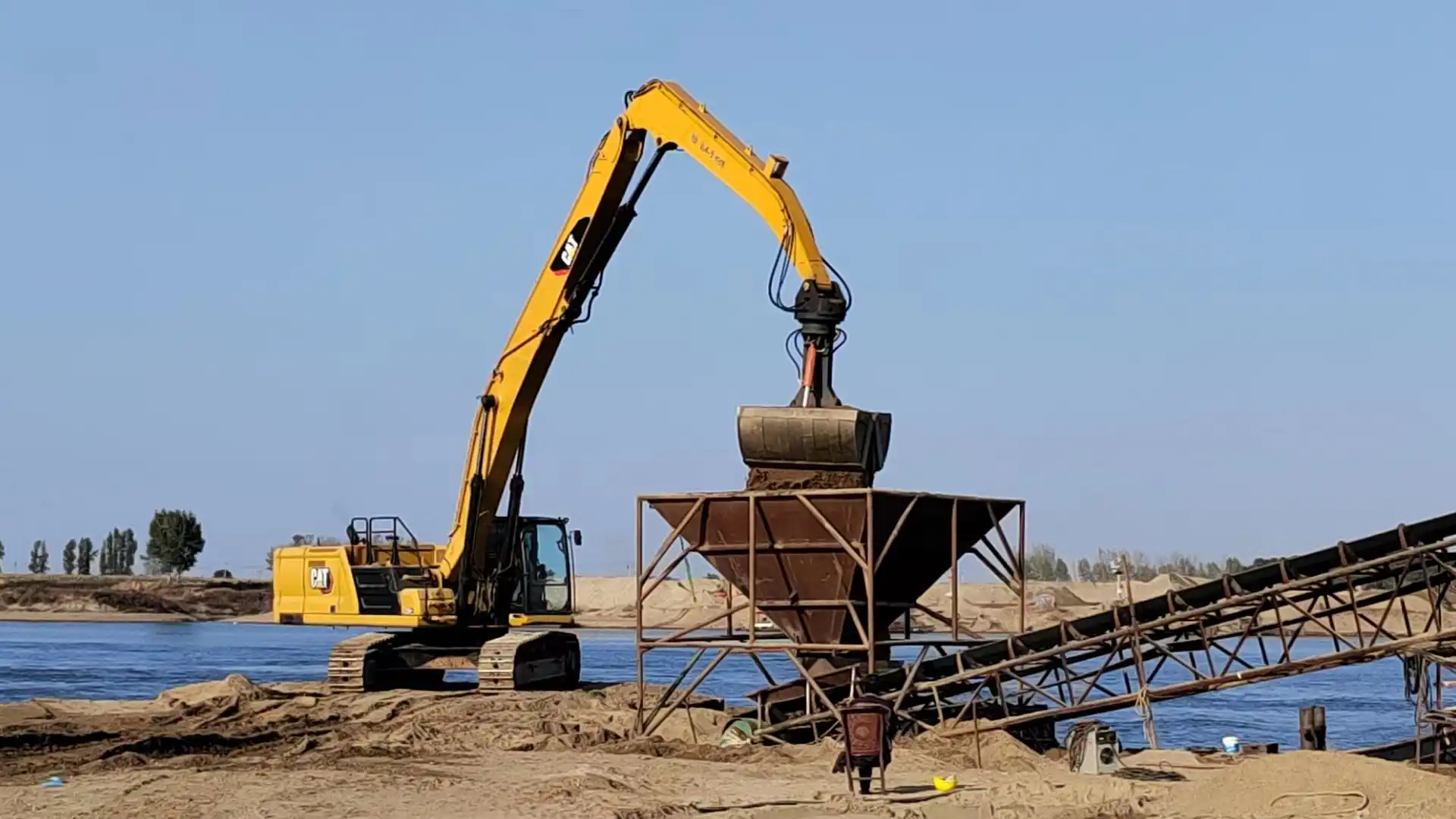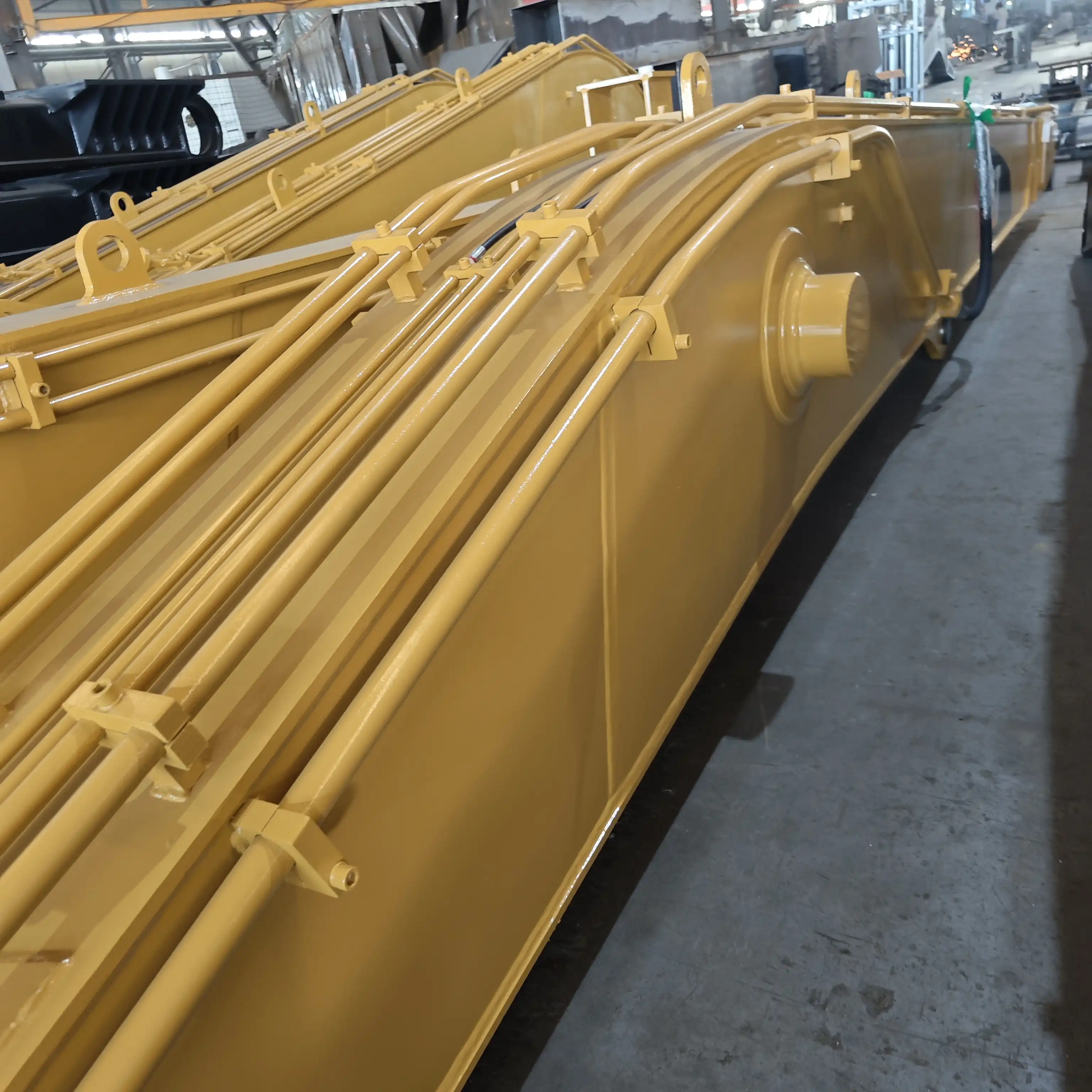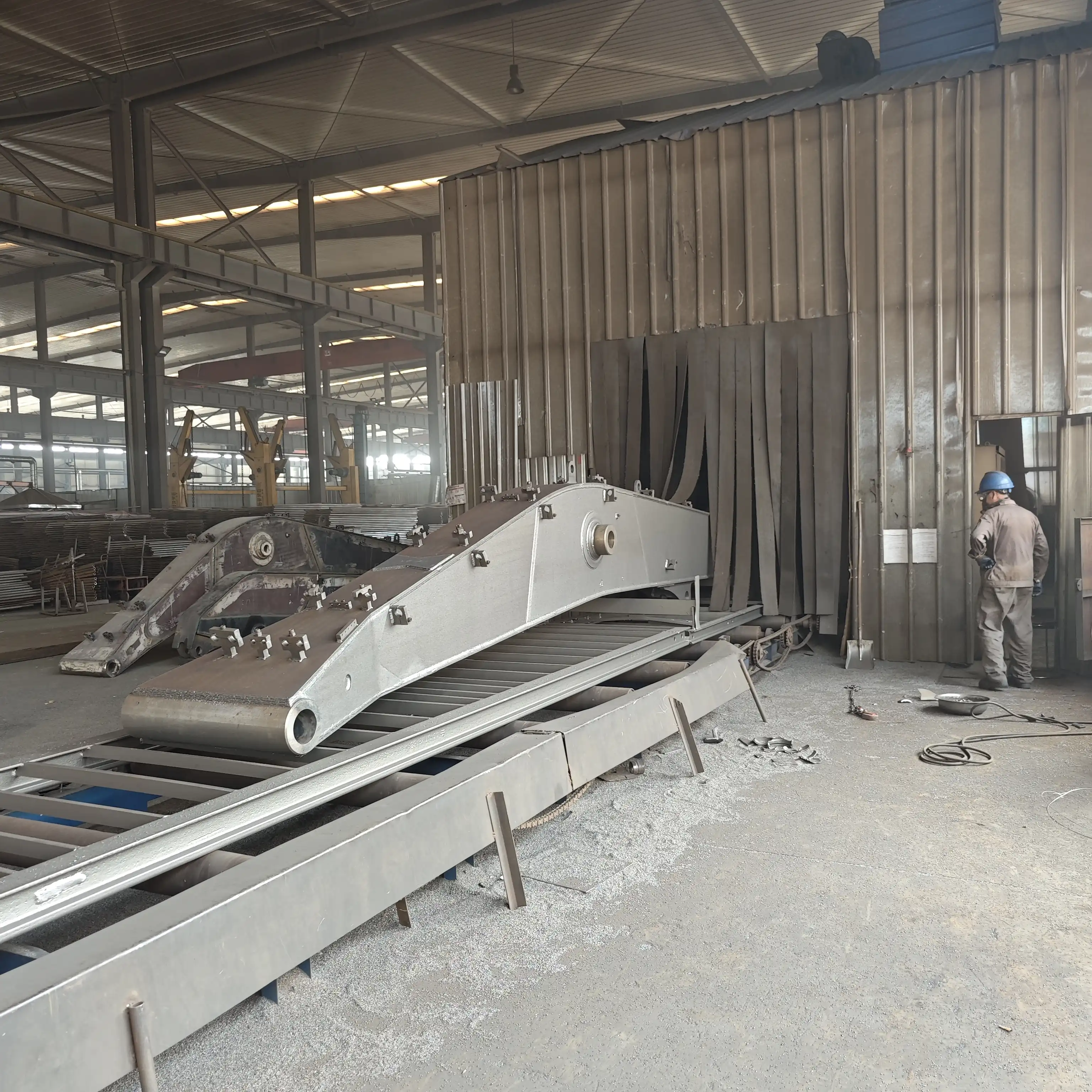What is an Excavator Material Handling Arm?
An excavator material handling arm, commonly known as an excavator grab arm, is a specialized attachment designed to enhance the functionality and versatility of standard excavators. These purpose-built arms transform conventional excavators into efficient material handling machines, enabling them to grab, lift, sort, and place various materials with precision and control. Unlike standard excavator arms that primarily focus on digging operations, material handling arms are specifically engineered with different geometries, reinforcements, and attachment points to optimize grabbing and lifting capabilities across diverse applications.
The grab arm typically consists of a main boom, stick, and a grabbing attachment that works in harmony to provide extended reach and superior material handling performance. These specialized arms are essential components in industries where efficient material movement is critical, including construction, demolition, waste management, scrap handling, forestry, and port operations. By replacing the traditional bucket with a grab attachment and utilizing a properly designed arm system, operators can significantly increase their machine's productivity and application range.
Manufacturers like Tiannuo Machinery have been at the forefront of developing high-performance material handling arms that balance strength, reach, and maneuverability. With over a decade of expertise in the field, companies like Tiannuo create custom solutions that address specific industry challenges, ensuring that each grab arm delivers optimal performance for its intended application while maintaining safety and efficiency.
Key Features & Design

Structural Engineering Principles
The foundation of an effective excavator grab arm lies in its structural engineering. These arms are designed using advanced computer modeling and stress analysis to ensure they can withstand the rigorous demands of material handling operations. Unlike standard excavator arms that primarily handle downward digging forces, material handling arms must manage complex multidirectional loads, especially when fully extended with heavy materials.
The geometry of these specialized arms typically features modified boom and stick configurations that prioritize horizontal reach over digging depth. This design philosophy incorporates strategic reinforcements at high-stress points and utilizes high-strength steel alloys that offer superior tensile strength without excessive weight. The pin connections between components are engineered with precision to minimize wear while facilitating smooth articulation throughout the arm's range of motion.
Hydraulic systems for material handling arms are also specially calibrated to provide precise control during grabbing operations. These systems often include additional hydraulic circuits and larger cylinders to manage the increased demands of grabbing and lifting operations. The hydraulic layout is designed to minimize pressure losses and heat generation, ensuring consistent performance even during extended operation periods.
Customization Options and Configurations
One of the most valuable aspects of modern excavator grab arm systems is their adaptability to specific operational requirements. Manufacturers like Tiannuo offer extensive customization options that allow operators to tailor their equipment to particular applications and environments. These customizations begin with basic parameters such as arm length, which can be optimized for specific reach requirements without compromising stability.
The grabbing attachment itself can be configured in numerous ways, from simple two-tine grabs to complex multi-tine designs with rotators and specialized gripping surfaces. For applications involving delicate materials, grabbing attachments can be fitted with protective pads or specialized contours that minimize damage while maintaining a secure grip. The opening width, closing force, and shape of the grab can all be tailored to match the specific materials being handled.
Control systems represent another area where customization adds significant value. Advanced material handling arms often incorporate specialized control interfaces that simplify complex grabbing operations. These can include programmable position memory, automatic leveling features, and load-sensing technology that adjusts hydraulic pressure based on material weight and density. For operations requiring exceptional precision, some systems even offer camera integration and visual guidance systems.
Manufacturing Process

Material Selection and Quality Control
The manufacturing of a high-performance excavator grab arm begins with the careful selection of materials that meet stringent quality standards. Leading manufacturers like Tiannuo Machinery prioritize the use of high-strength alloy steel plates for the main structural components, typically utilizing grades with excellent yield strength-to-weight ratios and superior resistance to fatigue and impact forces. These materials undergo comprehensive testing before being approved for production, including chemical composition analysis, metallographic examination, and mechanical property verification.
For components subject to high wear, specialized materials are selected based on their specific performance characteristics. Pin shafts, for example, are often manufactured from 40Cr steel that offers an excellent combination of strength, toughness, and wear resistance. Bushings at pivot points frequently utilize brass or composite materials that provide low friction operation while minimizing maintenance requirements. Hydraulic components are manufactured using precision-machined steel with specialized surface treatments to withstand the constant pressure cycling inherent in grabbing operations.
Quality control systems monitor the entire material supply chain, from initial sourcing through machining and final assembly. This includes dimensional verification at multiple production stages, non-destructive testing of critical welds, and rigorous documentation of material certifications. By maintaining strict material standards, manufacturers ensure their excavator grab arm products deliver consistent performance throughout their operational lifespan, even under the most demanding conditions.
Precision Fabrication Techniques
The transformation of raw materials into a finished excavator grab arm involves multiple precision fabrication processes. The process typically begins with computer-controlled plasma or laser cutting of steel plates according to detailed engineering specifications. These cutting systems achieve exceptional dimensional accuracy while maintaining the material's metallurgical properties, creating components that require minimal additional preparation before assembly.
The critical welding phase employs beveling techniques that prevent deformation and ensure complete penetration at joint connections. Skilled welders follow detailed procedures that specify parameters such as preheat requirements, electrode selection, and precise sequencing to minimize internal stresses. Computer-controlled welding robots may be utilized for consistent results on repetitive joints, while specialized fixtures maintain dimensional stability throughout the assembly process.
After welding, the entire assembly undergoes shot blasting to eliminate internal stresses and prepare the surface for protective coatings. This process not only improves the aesthetic appearance but also significantly enhances the corrosion resistance of the finished product. Final machining operations ensure precise alignment at all pin connections, optimizing movement smoothness and minimizing wear during operation. The completed excavator grab arm then undergoes meticulous inspection, including dimensional verification, weld quality assessment, and operational testing before receiving final approval.
Post-Production Treatment and Testing
The final stages of manufacturing are crucial to ensuring the long-term performance and reliability of an excavator grab arm. After fabrication is complete, the assembly undergoes a comprehensive stress-relieving process that typically involves controlled heating followed by gradual cooling. This treatment minimizes residual internal stresses from welding and forming operations, significantly reducing the risk of component failure during operational use.
Surface preparation and protective coating application represent another critical phase in the manufacturing process. After thorough cleaning and rust inhibition, multiple layers of specialized industrial coatings are applied under controlled conditions. These coating systems typically include zinc-rich primers for corrosion protection, intermediate layers for chemical resistance, and durable topcoats that withstand UV exposure and physical abrasion. The precise application techniques and careful curing ensure these protective systems provide years of reliable service even in harsh operating environments.
Before leaving the factory, each excavator grab arm undergoes a battery of performance tests designed to verify its operational capabilities and safety features. These tests typically include full-range motion verification, load testing at various extension positions, and simulation of typical working conditions. Hydraulic systems are carefully evaluated for proper pressure, flow rates, and cycle times, while control systems undergo calibration and functional verification. Only after successfully completing all these quality assurance steps is the arm cleared for delivery to the customer, ensuring it will meet or exceed performance expectations from the first day of service.
Advantages Over Standard Arms

Enhanced Productivity and Efficiency
The specialized design of an excavator grab arm delivers substantial productivity improvements compared to standard excavator configurations. The extended reach and precise grabbing capabilities allow operators to handle materials more efficiently, often reducing the need for material repositioning or multiple handling steps. This translates directly into faster cycle times and increased throughput for material handling operations across various industries.
The ability to securely grab and place materials with a single operation significantly reduces the time required for loading trucks, sorting recyclables, or managing waste materials. For example, in scrap metal handling applications, a properly configured material handling arm can potentially double the tonnage processed per hour compared to conventional methods. The precision control also minimizes damage to valuable materials, reducing losses and improving overall profitability.
Energy efficiency represents another significant advantage of specialized material handling arms. The optimized hydraulic systems and purpose-designed geometry reduce power consumption compared to adapting standard excavator arms for grabbing applications. This translates into reduced fuel consumption and lower operating costs, particularly important in today's environmentally conscious and cost-sensitive operational environments. Over the lifespan of the equipment, these efficiency gains can represent substantial cost savings while simultaneously reducing the environmental impact of material handling operations.
Application Versatility
One of the most compelling advantages of a specialized excavator grab arm is its remarkable versatility across diverse applications. Unlike purpose-built material handlers that excel in specific tasks but lack flexibility, an excavator equipped with a properly designed grab arm can quickly adapt to changing operational requirements. This adaptability is particularly valuable in industries where work conditions and material types vary significantly from project to project.
In port operations, for example, the same machine can efficiently unload bulk materials, handle containerized cargo, or manage loose items depending on the attached grabbing device. Construction and demolition operations benefit from the ability to sort different material types during the demolition process, separating recyclable components from general waste without requiring multiple specialized machines. The forestry industry utilizes these versatile arms for everything from timber handling to brush clearing and processing operations.
This application flexibility extends to the physical environment as well. Material handling arms can be configured for operation in confined spaces with restricted overhead clearance, on unstable surfaces where machine positioning is limited, or in environmentally sensitive areas where ground disturbance must be minimized. By maintaining the basic mobility and adaptability of the excavator platform while enhancing material handling capabilities, these specialized arms provide operational solutions for challenging environments where traditional material handling equipment cannot effectively operate.
FAQ
①What maintenance is required for an excavator grab arm?
Regular maintenance is essential for optimal performance and longevity of an excavator grab arm. This includes daily inspections of hydraulic components for leaks, checking pin connections for wear, and greasing all lubrication points according to the manufacturer's schedule. Weekly inspections should examine structural components for cracks or deformation, while monthly maintenance typically involves more comprehensive hydraulic system checks and torque verification on critical fasteners. Following the manufacturer's recommended maintenance schedule ensures reliable operation and prevents costly downtime.
②Can an excavator grab arm be installed on any excavator model?
While grab arms can be adapted to most excavator models, compatibility depends on several factors including the excavator's hydraulic capacity, structural strength, and stability characteristics. Manufacturers like Tiannuo Machinery offer customized solutions for various excavator models, ensuring proper integration with the machine's existing systems. For optimal performance and safety, it's essential to consult with specialists who can evaluate your specific excavator model and operational requirements before selecting and installing a material handling arm system.
③What is the typical lifespan of an excavator grab arm?
With proper maintenance and operation, a high-quality excavator grab arm typically provides 8-12 years of reliable service in normal working conditions. Factors affecting lifespan include operational intensity, material types handled, environmental conditions, and maintenance quality. Premium arms manufactured with high-strength alloys and proper stress distribution can significantly exceed this average lifespan. Many manufacturers offer refurbishment programs that can extend service life by replacing worn components and updating hydraulic systems while maintaining the original structural framework.
About Tiannuo
The grab arm represents a significant advancement in material handling technology, offering versatility, efficiency, and precision across diverse applications. These specialized attachments transform standard excavators into powerful material handling machines capable of addressing the most demanding operational challenges. By understanding the key features, manufacturing processes, and advantages these systems offer, equipment managers and operators can make informed decisions that optimize their material handling capabilities while controlling operational costs.
As industries continue to demand greater efficiency and adaptability from their equipment, the importance of properly designed and manufactured material handling arms will only increase. Companies like Tiannuo Machinery remain at the forefront of this evolution, developing innovative solutions that address emerging operational challenges while maintaining the reliability and durability that their customers depend on. Whether your operations involve construction materials, waste handling, scrap processing, or forestry products, a properly specified excavator grab arm can deliver the performance improvements needed to maintain a competitive advantage in today's challenging business environment.
For more information about grab arms and how they can benefit your specific applications, or to discuss customized solutions for your operational requirements, contact Tiannuo Machinery at arm@stnd-machinery.com. With over a decade of expertise in designing and manufacturing high-performance excavator attachments, their team can provide valuable insights and recommendations tailored to your unique operational needs.
References
Construction Equipment Guide (2023). "Advanced Material Handling Technologies in Modern Excavation Equipment."
Journal of Construction Engineering (2024). "Comparative Analysis of Specialized Excavator Attachments in Material Handling Applications."
International Association of Equipment Manufacturers (2023). "Trends in Excavator Attachment Design and Engineering: A Five-Year Industry Perspective."
Industrial Machinery Digest (2024). "Material Selection and Structural Engineering in Heavy Equipment Manufacturing."
Global Construction Review (2023). "Productivity Enhancement Through Specialized Excavator Configurations."
About Author: Arm
Arm is a leading expert in the field of specialized construction and railway maintenance equipment, working at Tiannuo Company.

